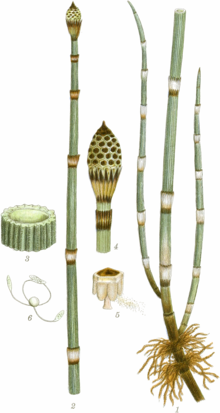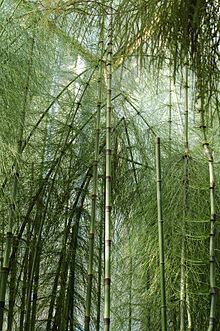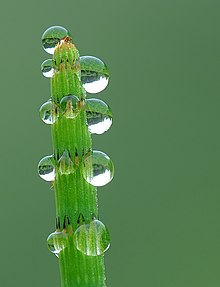Horsetail
| Horsetail | ||||||||||||
|---|---|---|---|---|---|---|---|---|---|---|---|---|

Young forest horsetail ( Equisetum sylvaticum ) |
||||||||||||
| Systematics | ||||||||||||
|
||||||||||||
| Scientific name of the order | ||||||||||||
| Equisetales | ||||||||||||
| Dumort. | ||||||||||||
| Scientific name of the family | ||||||||||||
| Equisetaceae | ||||||||||||
| Rich. | ||||||||||||
| Scientific name of the genus | ||||||||||||
| Equisetum | ||||||||||||
| L. |
The horsetail ( Equisetum ) are the only recent genus in the class of Equisetopsida within the ferns .
Horsetail species often grow on moist soil or in water. The field horsetail is considered a field weed , but is also an important medicinal plant .
description

Horsetail are perennial plants . They spread vegetatively with their rhizomes . With the exception of two tropical species, the species of the genus Horsetail ( Equisetum ) rarely exceed heights of growth of 2 meters.
They are easy to recognize by their rungs. Each rung is made of a series of nodes ( Nodi established) with intervening internodes. At each node inconspicuous leaves (microphylls) arise, and in some species also side shoots. Both the leaves and the branches are arranged in a whorl .
As hygrophytes , most species have hydathodes at the tips of the microphylls , which serve to increase the release of water.
The name horsetail comes from the fact that you can pull the stem axis out of the sheath formed by the leaves and put it back again. Rhizomes grow up to 6 meters long. Propagation is possible through runners and through individual, chopped up shoot pieces.
The spore containers ( sporangia ) are located five to ten on the underside of the sporangia carriers (" sporophylls "), which look like one-legged tables. These are arranged screw-like in cone-shaped sporophyll stands at the tip of the shoot. The spores are always designed in the same way, regardless of gender ( isospore ). The fossil calamites were partly heterosporous , so that it is assumed that the heterospore has been lost. On the outer layer (exospor) they have two bands ( hapteren ) with spatula-shaped ends, which are screwed around the spore when moist. If the spores dry out, the hackers unfold and thus create a bond between them. Some species carry the sporophyll levels on the green sprouts, others have special (not green) sprouts exclusively for reproduction.
Systematics






Since different species of the genus Equisetum form fertile hybrids , the exact number of species is controversial. A total of 15 to 20 species are assumed in the 21st century . The genus Equisetum is divided into two sub-genera:
- Subgenus Hippochaete
(Mild) Baker :
- Equisetum debile Roxb. ex Vaucher (also referred to by some authors as the subspecies Equisetum ramosissimum subsp. debile (Roxb. ex Vaucher) Hauke to Equisetum ramosissimum ).
- Equisetum giganteum L .: It is widespread in tropical South and Central America.
- Winter horsetail ( Equisetum hyemale L. ): It is widespread in Eurasia and from North to Central America. One can distinguish two subspecies.
- Equisetum laevigatum A. Brown : It is distributed from North America to Mexico.
- Equisetum myriochaetum Schltdl. & Cham. : It is common in the New World.
- Branched horsetail ( Equisetum ramosissimum Desf. ): It is widespread in the Old and New World.
- Rush-shaped horsetail or dwarf horsetail ( Equisetum scirpoides Michx. ): It is widespread in the northern hemisphere.
- Colorful horsetail ( Equisetum variegatum Schleich. Ex F.Weber & D.Mohr ): It is widespread in the northern hemisphere.
- Subgenus Equisetum :
- Field horsetail ( Equisetum arvense L. ): It is widespread in the northern hemisphere.
- Equisetum bogotense Kunth : It is widespread from Central to South America.
- Equisetum diffusum D.Don : It is common in Southeast Asia.
- Pond horsetail ( Equisetum fluviatile L. , Syn .: Equisetum limosum L. ): It is widespread in the northern hemisphere, but also occurs in Queensland.
- Marsh horsetail , duwock ( Equisetum palustre L. ): It is widespread in the northern hemisphere.
- Meadow horsetail ( Equisetum pratense Ehrh. ): It is widespread in the northern hemisphere.
- Forest horsetail ( Equisetum sylvaticum L. ): It is widespread in the northern hemisphere.
- Giant horsetail ( Equisetum telmateia Ehrh. , Syn .: Equisetum maximum auct.): It is widespread from Europe through North Africa to West Asia and also in North America.
- Natural hybrids :
- Alsatian horsetail ( Equisetum × alsaticum (HPFuchs & Geissert) G.Philippi ) = Equisetum hyemale × Equisetum variegatum × Equisetum hyemale .
- Ascending horsetail ( Equisetum × ascendens Lubienski & Bennert ) = Equisetum hyemale × Equisetum ramosissimum × Equisetum hyemale .
- Dyces horsetail ( Equisetum × dycei C.N.Page ) = Equisetum fluviatile × Equisetum palustre , Origin : Great Britain, Germany.
- Equisetum × ferrissii Clute = Equisetum hyemale × Equisetum laevigatum , home: North America.
- Font Quers horsetail ( Equisetum × font-queri Rothm. ) = Equisetum palustre × Equisetum telmateia .
- Geissert's horsetail ( Equisetum × geissertii Lubienski & Bennert ) = Equisetum hyemale × Equisetum ramosissimum × Equisetum variegatum .
- Shore horsetail ( Equisetum × litorale Kühlew. Ex Rupr. ) = Equisetum arvense × Equisetum fluviatile , home: Europe, Asia, North America.
- Southern horsetail ( Equisetum × meridionale (Milde) Chiov. ) = Equisetum ramosissimum × Equisetum variegatum , home: Switzerland, Northern Italy, Czech Republic, Slovakia.
- Mild horsetail ( Equisetum × mildeanum Rothm. ) = Equisetum pratense × Equisetum sylvaticum .
- Moore's horsetail ( Equisetum × moorei Newman ) = Equisetum hyemale × Equisetum ramosissimum
- Rough horsetail ( Equisetum × trachyodon (A.Braun) WDJKoch ) = Equisetum hyemale × Equisetum variegatum .
Paleobotany
The recent horsetail are the last survivors of a formerly species-rich group within the vascular spore plants ( Pteridophyta ), the Equisetopsida. This taxon also includes the family of the Calamitaceae to which the fossil representatives of the Kalamites ( Calamites ) and the genus Arthropitys are counted, which are known from fossils from the Permian and Carboniferous . They were lignified, reached heights of up to 30 meters and a trunk diameter of 1 meter and formed an important part of the hard coal forests . The first horsetail appeared in the upper Devonian about 375 million years ago ( Pseudobornia bronni ). The horsetail can therefore be called "living fossils" .
use
Only the sterile summer fronds of the field horsetail ( Equisetum arvense ) are used medicinally as a diuretic and are used for rheumatism , inflammation , kidney disease , urinary gravel, and earlier also for tuberculosis . According to Kneipp , horsetail has very astringent powers; they clean the blood , stomach , kidneys and bladder , but are also externally cleansing and astringent for rashes and wounds.
A peculiarity of horsetail is the storage of silicates (as a lignin substitute ) in the cell wall. The plant contains up to 7% silica . These deposits make horsetails to a gentle abrasive ( horsetail ).
literature
- Peter Sitte , Elmar Weiler , Joachim W. Kadereit , Andreas Bresinsky , Christian Körner : Textbook of botany for universities . Founded by Eduard Strasburger . 35th edition. Spektrum Akademischer Verlag, Heidelberg 2002, ISBN 3-8274-1010-X .
- Nele Wellinghausen: Fern plants. Identification key for all domestic ferns, wild mats and horsetail. 7th edition. German Youth Association for Nature Observation (DJN), Hamburg 1997, ISBN 3-923376-13-8 .
- Karl Ulrich Kramer (Hrsg.): Illustrated flora of Central Europe. Pteridophyta, Spermatophyta . Founded by Gustav Hegi. 3rd, completely revised edition. Volume I. Part 1 Pteridophyta . Paul Parey, Berlin / Hamburg 1984, ISBN 3-489-50020-2 , p. 54-79 .
- Walter Erhardt , Erich Götz, Nils Bödeker, Siegmund Seybold: The great pikeperch. Encyclopedia of Plant Names. Volume 2. Types and varieties. Eugen Ulmer, Stuttgart (Hohenheim) 2008, ISBN 978-3-8001-5406-7 .
- Negotiations of the Imperial Leopoldino-Carolinian German Academy of Natural Scientists . Volume two and thirty (Volume four and twenty), Second Section, Blochmann, Dresden 1867, online at biodiversitylibrary.org, accessed on September 28, 2018.
- Li-Bing Zhang, Nicholas J. Turland: Equisetaceae , p. 67 - online with the same text as the printed work , In: Wu Zheng-yi, Peter H. Raven, Deyuan Hong (ed.): Flora of China. Volume 2-3: Lycopodiaceae through Polypodiaceae. Science Press and Missouri Botanical Garden Press, Beijing and St. Louis, 2013, ISBN 978-1-935641-11-7 .
Individual evidence
- ^ Peter Sitte , Elmar Weiler , Joachim W. Kadereit , Andreas Bresinsky , Christian Körner : Textbook of botany for universities . Founded by Eduard Strasburger . 35th edition. Spektrum Akademischer Verlag, Heidelberg 2002, ISBN 3-8274-1010-X , p. 746 .
- ↑ Li-Bing Zhang, Nicholas J. Turland: Equisetaceae , p. 67 - online with the same text as the printed work , In: Wu Zheng-yi, Peter H. Raven, Deyuan Hong (ed.): Flora of China. Volume 2-3: Lycopodiaceae through Polypodiaceae. Science Press and Missouri Botanical Garden Press, Beijing and St. Louis, 2013, ISBN 978-1-935641-11-7 .
- ↑ a b c d e f g h i Equisetum in the Germplasm Resources Information Network (GRIN), USDA , ARS , National Genetic Resources Program. National Germplasm Resources Laboratory, Beltsville, Maryland. Retrieved December 20, 2019.
- ↑ a b c d e Marcus Lubienski: The horsetail (Equisetaceae, Pteridophyta) of the flora of Germany - an updated identification key. In: Yearbook of the Bochum Botanical Association . Volume 2, 2011, pp. 68–86 ( PDF 6.7 MB)
- ^ Marcus Lubienski, Wolfgang Jäger, H. Wilfried Bennert: Equisetum ascendens Lubienski & Bennert (Subg. Hippochaete, Equisetaceae), a new horsetail clan for the flora of North Rhine-Westphalia. Yearbook of the Bochum Botanical Association. Volume 3, 2012, pp. 7-20 ( PDF 3.4 MB)
Web links and further literature
- Determination of the wild horsetail species in Germany.
- Marcus Lubienski: The horsetail (Equisetaceae, Pteridophyta) of the flora of Germany - an updated identification key. In: Online publications of the Bochum Botanical Association. Volume 2, No. 6, pp. 82-100, (PDF file).
- Fossil horsetail in the WiKi Mineral Atlas
- Link directory fossil and recent horsetail (English)
- Photos of Equisetites arenaceus on p. 65 (PDF page 15)
